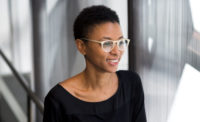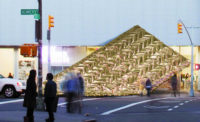Last month, Hurricane Matthew tore through Haiti with 145-mile-per-hour winds, causing complete devastation along the Caribbean country’s southwestern coast. Although the capital of Port-au-Prince was spared this time, the storm has hampered ongoing attempts to rebuild the city, still hamstrung from the 2010 earthquake that killed nearly a quarter of a million people. Among the architects who are part of the earthquake recovery efforts, the 2-year-old design and research studio Emergent Vernacular Architecture (EVA) has made an impact with a number of socially attuned civic spaces.
EVA Studio's eight projects in Haiti—an amalgam of community spaces, houses, and educational facilities—are characterized by an energetic aesthetic: vibrant colors, verdant landscaping, and a textured palette of local materials such as adobe and recycled metal. Just as the London- and Port-au-Prince-based firm incorporates patterned details onto surfaces ranging from pavement to window shutters, it seeks social, cultural, and economic patterns within a site to inform a design solution.
The firm began to take shape when co-founder Andrea Panizzo left his job working for Massimiliano Fuksas in 2010. Shortly after resigning, he left Rome for Bolivia, where he worked on numerous design projects—including an arts center—for the nonprofit organization Alalay. “I was asking myself questions about where the profession was going,” says Panizzo, 37. “I came to realize how architects could have a positive social impact, and how we could help social needs in the global South.”
Panizzo relocated from Bolivia to Haiti shortly after the earthquake, volunteering with Architecture Sans Frontières for about eight months. He then became the lead designer for a local contractor—an opportunity that led to his work on MASS Design Group’s GHESKIO cholera treatment center, and a competition to rebuild the historic Port-au-Prince Cathedral.
As he forayed into solo work in Port-au-Prince, Panizzo began talking to a friend, Simone Pagani, about founding a private practice there. The pair then recruited Jeannie Lee (who has since left), Pagani’s colleague from Rafael Viñoly’s London office, and tested the waters together by entering a bold proposal for the 2014 Guggenheim Helsinki design competition. Although their submission did not move forward (the competition had a record-breaking 1,715 entries), the trio decided to establish the now 11-person firm.
The firm’s first commission, an American Red Cross–funded 16,000-square-foot public space called Tapis Rouge, was completed this past September, and provides a ring-shaped open-air amphitheater with areas for market kiosks, benches, and landscaping, to serve an informal neighborhood of displaced people in Port-au-Prince. As with all of EVA Studio's projects, community participation was integral to every stage of Tapis Rouge’s development. “The project’s physical form was created by the community,” says Panizzo. “They asked for gathering spaces and different terraces, so we came up with these concentric rings.” Additionally, locals made up 75 percent of the project’s construction workers. “In the end, they’re the ones who are going to own the space,” he says.
Despite the magnitude of October’s hurricane, Panizzo says that EVA Studio's projects were not badly affected (“We only lost one small tree,” he says), a fact he attributes to their locations, and to the drainage strategies designed by the firm’s group of engineers. Ecole de l’Espoir, a recently completed school in Port-au-Prince’s Delmas 32 neighborhood, stayed closed during the storm, but reopened to students shortly after. Another educational and rehabilitation center for children, located south of Port-au-Prince in the town of Bois Tombé, is scheduled to be completed in 2017.
Panizzo now oversees projects with Pagani from EVA Studio’s London office, where about half of the staff is located, focusing on schematic design, while the Port-au-Prince satellite oversees community engagement and construction. Although the firm has been able to sustain itself with its current humanitarian work, Panizzo admits it is difficult, but he manages to travel to Haiti about once a month.
The firm is also looking beyond Haiti. In addition to finding work in London, Panizzo hopes to address the global refugee crisis by researching informal neighborhoods and social housing in Europe and the Middle East. But EVA’s work in Haiti will be ongoing: “We want to keep going back to see how people are using the spaces,” he says. “Architecture doesn’t stop when architects leave.”
















Post a comment to this article
Report Abusive Comment